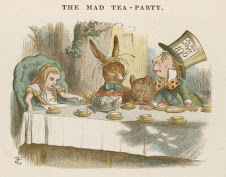From a lengthy new report by the
Pew Research Center, "Beyond Red vs. Blue: The Political Typology":
a growing number of Americans are choosing not to identify with either political party, and the center of the political spectrum is increasingly diverse. Rather than being moderate, many of these independents hold extremely strong ideological positions on issues such as the role of government, immigration, the environment and social issues. But they combine these views in ways that defy liberal or conservative orthodoxy.
For political leaders in both parties, the challenge is not only one of appeasing ideological and moderate “wings” within their coalitions, but rather holding together remarkably disparate groups, many of whom have strong disagreements with core principles that have defined each party’s political character in recent years . . . .
The new political typology finds two groups that are clearly Republican in their political orientation, three that are predominantly Democratic, and – reflecting the growing number of independents – four in which majorities eschew party labels. Within this broad political center are two Republican-leaning groups and one Democratic-leaning group, along with the politically uninvolved Bystanders.
On the right, Staunch Conservatives and Main Street Republicans overwhelmingly identify as Republicans. Similarly, on the left large majorities of Solid Liberals and Hard-Pressed Democrats consider themselves Democrats. While a majority of New Coalition Democrats identify with the Democratic Party, many consider themselves independents (though most say they lean toward the Democratic Party).
The middle is far more diverse. Although majorities in all of these groups identify as political independents, 77% of Libertarians and 60% of Disaffecteds lean to the GOP while 58% of Post-M0derns lean to the Democratic Party. The politically disengaged Bystanders – who do not vote or follow politics – lean somewhat to the Democratic Party.




5 comments:
I took Pew's survey and stood revealed as a "Solid Liberal" because the bipolar questions didn't allow for nuance. To be identified, you have to choose whichever answer of two comes closest to your actual beliefs. As for the respondents to the actual survey, I'd be curious to see how many of them actually ever voted for an independent candidate.
I am apparently a "Libertarian." With these kinds of tests, it's always interesting though to play around with the answers and see which answers skew the outcome in one way or another.
Another problem with the format, imo, was that a bunch of the prompts were not mutually exclusive or opposites or whatever: ex. government regulation is necessary vs. government regulation does more harm than good.
I got "Solid Liberal", and kind of laughed/was annoyed there were zero nuance to the questions at all. It also basically told me I'm a Democrat.
the study seems to place solid liberals just beyond the Democrats - at least nominally, maybe they are more Independent, according to their metric? Same could be said of the "staunch conservatives". But then they don't include solid liberals or staunch conservatives among Independents, who they frame as forming the "middle".
http://thenewthirdparty.blogspot.com
Post a Comment